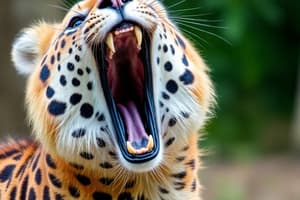Podcast
Questions and Answers
What are the two types of influences that can modify an animal's behaviour?
What are the two types of influences that can modify an animal's behaviour?
Environmental and pharmacologic influences.
What are the three steps in describing a behaviour?
What are the three steps in describing a behaviour?
Structure, consequences, and patterns.
What are the six patterns of behaviour?
What are the six patterns of behaviour?
Courtship and mating, parental care, social affiliation, feeding, defence, and periodic or cyclic.
What is the purpose of courtship and mating behaviours?
What is the purpose of courtship and mating behaviours?
What is the relationship between the number of offspring produced and the amount of energy invested in parental care?
What is the relationship between the number of offspring produced and the amount of energy invested in parental care?
What is the primary function of social affiliation behaviours?
What is the primary function of social affiliation behaviours?
What is the main goal of foraging behaviours?
What is the main goal of foraging behaviours?
What is an example of a behaviour that can be modified through counterconditioning?
What is an example of a behaviour that can be modified through counterconditioning?
What is the key factor in determining whether a series of movements is considered a behaviour?
What is the key factor in determining whether a series of movements is considered a behaviour?
What is the primary goal of an animal's actions?
What is the primary goal of an animal's actions?
What is the main difference between innate and learned behaviour?
What is the main difference between innate and learned behaviour?
What is the significance of the nature vs nurture debate in the context of animal behaviour?
What is the significance of the nature vs nurture debate in the context of animal behaviour?
What is the process of imprinting, and what is its significance?
What is the process of imprinting, and what is its significance?
What are the three factors that influence an animal's behaviour?
What are the three factors that influence an animal's behaviour?
What is the difference between habituation, desensitisation, and sensitisation?
What is the difference between habituation, desensitisation, and sensitisation?
What is counterconditioning, and how does it affect an animal's response to a stimulus?
What is counterconditioning, and how does it affect an animal's response to a stimulus?
Flashcards are hidden until you start studying
Study Notes
Behaviour and Ethology
- Behaviour: a series of movements with a beginning, middle, and an end, considered in the context of why it occurred
- Ethology: the study of animal behaviour
Goal-Driven Actions
- Goal-driven actions are essential for survival, ensuring the obtaining of resources such as food, space, communication, and reproduction
- Measurable at the level of the entire animal
Forms of Behaviour
- Innate behaviour: genetically hardwired in an organism, can be performed in response to a cue without prior experience (e.g., knee jerk)
- Learned behaviour: a behavioural response developed due to experience
Nature vs Nurture
- Instinct (nature) and learning (nurture) are essential for survival, allowing animals to adapt their behaviour to their environment
- Adaptation occurs through two processes: evolution (at a population level) and learning (at an individual level)
Influences on Behaviour
- 3 factors influencing behaviour: genetics, environment (current), and learning (previous experience)
- The 3 S's in behaviour: selection, socialisation, and stimulation
Learning and Conditioned Response
- Imprinting: phase-sensitive learning that is rapid and independent of behavioural consequences (e.g., social bond formed with mother geese)
- Habituation: stopping response to repeated, inconsequential events
- Desensitisation: decrease in response due to gradual exposure to a stimulus
- Sensitisation: increase in response to a stimulus
- Counterconditioning: changing the way an animal feels about a stimulus, resulting in changes in their response
Environmental and Pharmacologic Influences
- Environmental factors/triggers: physical, space, stimuli (visual/olfactory/auditory), other animals, devices/objects
- Pharmacologic influences: drug therapy
Describing Behaviour
- 3 steps for describing behaviour:
- Structure: appearance of the physical manifestation of a behaviour (e.g., lick paw and swipe over face)
- Consequences: effects of behaviour on the animal, another animal, or the environment (e.g., grooming)
- Patterns: event (short duration) or state (long duration) (e.g., removing fluff from whisker & full face groom)
Patterns of Behaviour
- 6 patterns of behaviour:
- Courtship and mating
- Parental care
- Social affiliation
- Feeding
- Defence – territorial
- Periodic or cyclic – migration
Patterns of Behaviour (In-Depth)
Courtship and Mating
- Behaviours that help members of the same species identify and select mates
- Sexual selection: an evolutionary mechanism that increases an individual's chance of breeding and passing on genetic information
Parental Care
- Reproduction and care of offspring require a lot of energy
- In mammals, usually provided by the female, allowing males to maximise reproductive output
Social Affiliation
- Reinforces social bonds between animals in a group
- Examples: allogrooming, smiling/waving, play, mutual benefit to all animals involved
Studying That Suits You
Use AI to generate personalized quizzes and flashcards to suit your learning preferences.





